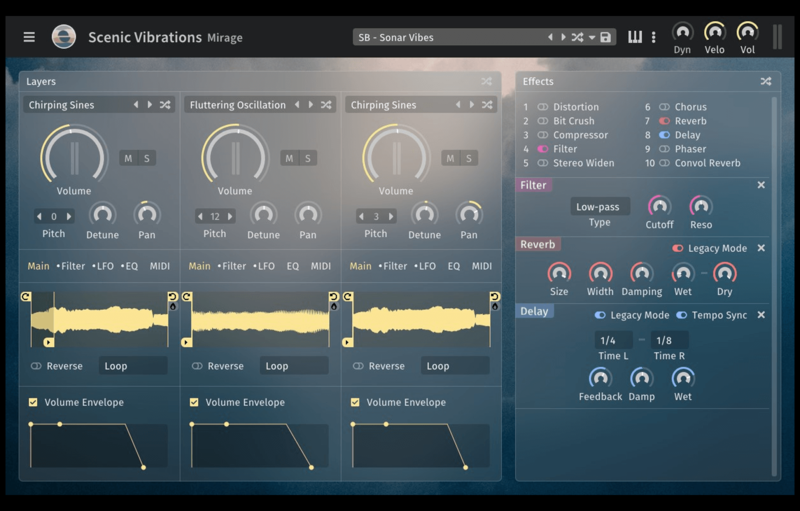Picturesque Tonal Resonations Synth – Unique Scenic Sounds
An Organic Synth
The sound of Scenic Vibrations is primarily organic in nature – with intriguing harmonics and natural swells of intensity. But at the same time, it is not wholly familiar to the ear. This dual-character makes Scenic Vibrations fit well with both your synthetic sound design and real instrumentation.
As well as a companion synth, Scenic Vibrations can take the lead too. Melodic lines played with Scenic Vibrations are ear-catching and thoroughly unique sounding.
Surface Transducer
The 30 instruments that make up Scenic Vibrations are created from a set of recordings of metal objects resonating with a surface transducer. Objects such as sheets of metal, koto strings, bass guitar strings and suspended steel frames were used. A surface transducer is a small electronic device that can be placed onto any resonant surface. When a signal is sent to the device, it causes the surface to audibly vibrate and resonate; in essence, turning the object into a speaker. Each sample is roughly 20 seconds long and has been tuned and made into a seamless loop.
30 Categorised Instruments
Each sample has been made into a separate ‘instrument’ in Mirage. This means you can control each aspect separately, and layer up different sounds in Mirage’s three-layer architecture. These instruments are conveniently categorised based on timbre.
- The first category is called Basic, which contains waveform-like samples. These samples don’t have a massive amount of movement in them. They are the bedrock sounds, perfect for blending with other layers.
- Secondly is the Core category. This is the largest. It features a set of tonal resonations, most of which are musically consonant. Here you will find fluttering vibrations, swelling oscillations and tonal hums.
- Lastly is the Dark category. This contains sounds that are more edgy, experimental and sometimes dissonant. These are an excellent component for creating dark ambiences and tension.
Customisable Sound Design
It is easy to create custom sounds or edit presets with Scenic Vibrations. Mirage, the VST/AU engine that powers it, features a three-layer core. On each layer, you can load up one of the 30 instruments and control its volume envelope, EQ, LFO, pitch and much more. By blending together multiple sounds, you can create new timbres. And with the ‘randomise all instruments’ button, you can quickly trial a whole new set of instruments and see what fits in your track.
Sound Design by Si Begg, utilising two decades of experience
Si Begg has been working in the music industry for over two decades. His work recently has been in part on wide-ranging scores for film, TV and trailers, including Netflix show Lovesick. His technical skill and ear for usable sound design shine through in Scenic Vibrations. The sampling, editing and lots of the presets are made by him. Scenic Vibrations already plays a part in his professional work.
Over 100 presets
Scenic Vibrations comes with everything you need for adding production-ready sounds to your track. Just use the preset browser to try some of the included 107 factory presets which were designed my Si Begg and Sam Windell. There are many types of sounds among these. Including suspenseful keys, dark ambiences, fluttering pads and droning bass-pads. Once you find the sound you like, it is possible to further customise it with Mirage’s easy-to-use interface.
Specifications
-
107 presets, saved as separate mirage-scenic-vibrations files
-
Mirage sample-based synthesis engine included
-
Scenic Vibrations Mirage library (closed format mdata file) which features 30 instruments
-
~77MB file download
What is Mirage?
Mirage is our sample-based synthesis engine. It is a VST/AU synthesiser plugin that features a powerful set of controls for processing our custom sample libraries, such as Phoenix or Wraith (currently libraries can only be made with our internal tools).
Mirage is designed for rapid, flexible sound design and for ease-of-use.
A rack of built-in Effects
Another technique that sound designers use to shape the character of sounds is by applying effects. Mirage features a rack of such effects for this purpose. Built-in effects such as distortion, bit-crush, chorus and stereo widener can be used to enhance the sound with extra harmonics or extra simulated width.
The compressor can be used to control dynamics or add punch, and the filter can be used to isolate just the frequencies you need. Mirage also has reverb and delay effects for real space simulation. These are great for sound design too.
One of the reverb effects is a convolution reverb, this is typically used to add a real-sounding reverberation effect to the signal by using samples of real spaces (impulse responses). However, by substituting the sample of a real space with an abstract sample, interesting effects can be produced. Mirage features both realistic impulse responses and abstract ones for creative sound design.
Minimum friction from your mind to your DAW
Mirage is designed to not get in your way. It is fast to load up and is CPU efficient. It has a vector-based GUI that can be resized so that it will work on any size screen. The controls are laid out in an intuitive way, and a full description of what each control does can be viewed by hovering the mouse over it for a moment. Mirage also comes with a PDF user manual with all of the nitty-gritty details covered.
- Windows 7 or higher, 64-bit only (the plugin has a 32-bit version but the installer requires a 64-bit machine – virtually all Windows machines are 64-bit)
- Or MacOS 10.12 or higher, both Intel and M1 chips are supported (universal binary)
- A DAW that can host a VST2 or AudioUnit v2 (AU) plugin. Examples of such hosts are Cubase, Ableton Live, Studio One, Reaper, Reason, FL Studio, Logic X, Garage Band, and many more. Logic 9 and Pro Tools are not supported.




















